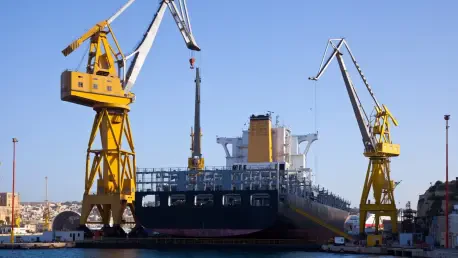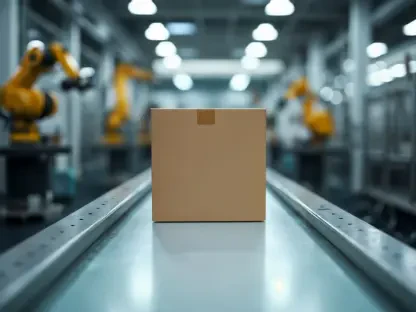Maritime trade serves as the backbone of global commerce, facilitating the movement of goods across continents. Efficiency and technology are critical factors in this sector’s evolution. Leading the charge in this technological revolution is the Port of NEOM in Saudi Arabia, which introduces fully automated, remote-controlled cranes. These advanced systems aim to optimize operations and transform logistics, aligning with global trends toward sustainable innovation and enhanced commercial competitiveness.
Breaking Down the Features of Automated Cranes
Automated port cranes represent a leap forward in logistics, specifically ship-to-shore and electric rubber-tyred gantry (eRTG) models that redefine operational capabilities. Equipped with systems for remote control, these cranes significantly reduce human error, enhancing precision during cargo handling operations. This advancement is crucial for ports striving to maintain high throughput and minimize downtime, allowing operators to manage complex tasks without direct manual intervention.
Sustainability underpins the operational ethos of eRTG cranes, using electricity over traditional fuel sources. These systems contribute to reduced emissions and bolster environmental stewardship. By integrating green technology, ports can achieve greater operational efficiency while simultaneously curbing carbon footprints. This dual benefit emphasizes the vital role of port automation in adhering to global environmental standards and promoting sustainable practices.
Recent Progress and Market Dynamics
In a rapidly evolving technological landscape, automated crane technology has undergone notable advancements. These improvements include enhanced sensor systems that facilitate real-time data analysis and monitoring, affording operators superior control and adaptability to changing conditions. Notably, innovations in AI have paved the way for smarter decision-making processes, allowing cranes to autonomously adjust operations based on cargo types and weather conditions.
NEOM’s approach embodies the broader industry trend, balancing cutting-edge technology with workforce preparedness. Training programs are indispensable, integrating local talent, including Saudi women, into high-tech roles. This initiative is not just a business necessity but a powerful commitment to societal progression, reflecting a new era in workforce diversification within Saudi Arabia’s ambitious Vision 2030.
Implementing Innovation Across Industries
The widespread implementation of automated cranes has already begun to reshape port operations around the globe. NEOM’s strategic position as a key Red Sea trading hub is enhanced by the integration of such technology, showcasing a powerful example of modern logistical infrastructure. The focus on East-West trade routes aims to set new benchmarks in speed and efficiency, ensuring the port’s competitive edge in a dynamic market.
Unique use cases abound, with ports adopting a blend of technology and human resource capability. These applications exemplify innovative adaptability, positively transforming historical bottlenecks in trade processes. Automated systems have shown marked improvements in productivity and cost savings, particularly in sectors requiring high throughput and accuracy.
Overcoming Barriers to Adoption
Despite the obvious benefits, the path to widespread adoption of automated crane technology is fraught with challenges. Technical limitations, including systems compatibility and cybersecurity concerns, pose significant hurdles. Additionally, regulatory requirements often lag behind technological advancements, complicating seamless integration across varied international contexts.
The pursuit of solutions continues, with stakeholders investing in research to mitigate these barriers. Collaborative efforts between technology providers, port authorities, and regulatory bodies are crucial to fostering an environment conducive to innovation. Addressing societal and technical obstacles ensures that the potential of automated cranes is fully harnessed, aligning with future economic and environmental goals.
Envisioning the Future Trajectory
Looking ahead, the trajectory of automated port crane technology points toward further breakthroughs. Emerging advancements in AI and machine learning are expected to drive innovation in predictive maintenance and intelligent automation. These technologies promise unparalleled operational precision and adaptability, setting the stage for next-generation maritime logistics.
As the industry moves toward greater interconnectedness, the role of automated cranes in transforming port operations is set to grow. Creating resilient and adaptive logistical chains will be paramount, ensuring that the maritime sector remains steadfast in its ability to meet global commerce demands. The ongoing evolution of technology heralds a transformative era for ports, seamlessly blending sustainability with efficiency.
Evaluating the Impact
In conclusion, advancements in automated port crane technology have been instrumental in reshaping maritime logistics. The integration seen at NEOM serves as an exemplary model, showcasing the successful blend of technological innovation and human capital development. While challenges persist, the ongoing pursuit of solutions and adaptations illustrates the industry’s commitment to progress. As innovative technologies continue to evolve, their impact on sustainability, efficiency, and workforce diversification will remain substantial, driving the industry toward a robust and dynamic future.









